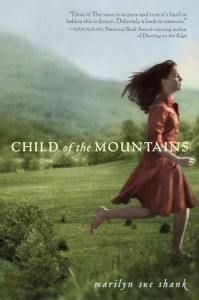 The notion of a “bleached” culture or absence of culture among white people looms large, and young adult authors are working to dispel that belief as they explore the diversity of what it means to be white. Phyllis Reynolds Naylor’s book Faith, Hope, and Ivy June (Delacorte, 2009) and now Child of the Mountains by Marilyn Sue Shank are appropriate for performing some myth-busting as well as providing a door for cultural discussions with a focus on diverse lifestyles, especially those conditions imposed by class differences and geographical circumstances.
The notion of a “bleached” culture or absence of culture among white people looms large, and young adult authors are working to dispel that belief as they explore the diversity of what it means to be white. Phyllis Reynolds Naylor’s book Faith, Hope, and Ivy June (Delacorte, 2009) and now Child of the Mountains by Marilyn Sue Shank are appropriate for performing some myth-busting as well as providing a door for cultural discussions with a focus on diverse lifestyles, especially those conditions imposed by class differences and geographical circumstances.
Set in 1954 in the mountains of West Virginia, Shank’s book features eleven-year-old Lydia Hawkins who speaks the lyrical language of the hills. Here, poverty is rampant, but Appalachians value close bonds with family, friends, and neighbors and measure richness by other means. When Lydia’s brother BJ is diagnosed with cystic fibrosis and Mama agrees to participate in a research study so that BJ can receive medical treatment, the consequences of her decision leech all color from life for Lydia. Mama ends up in jail, and Lydia learns several new meanings for the term solitary. She also learns lessons about human cruelty and the tendency to hate, reject, or ignore what one doesn’t know or even try to understand. The reader grows attached to Lydia and her efforts to not “let our sad rob us of joy” (254), especially after Lydia discovers she has been living a lie. While the uncovered truth liberates her, it also traps her and threatens suffocation. A dog named Ears, her teacher Mr. Hinkle, and the act of writing provide catharsis.
Thematically similar to Do Not Pass Go by Kirkpatrick Hill (Simon and Schuster, 2007), where Deet’s father lands in jail and Deet’s view of prisons and prisoners begins to change when he learns people’s stories, Lydia experiences the power of love, hope, and truth. Ultimately, from this great evil that befalls her, some good comes. By writing through her anxiety, Lydia acknowledges the good that comes from her mother’s imprisonment. Through Lydia, readers also realize some things are invisible until they happen to us. We might not give a second thought to prisons and prisoners until a family member is jailed; we may be blind to ignorance and hate as diseases until we are victims.
- Posted by Donna

